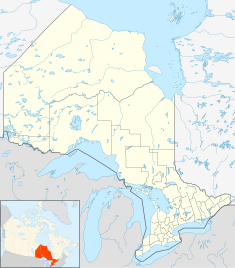|
Kay-Nah-Chi-Wah-Nung
The Kay-Nah-Chi-Wah-Nung Historical Centre, or Manitou Mounds,[4] is Canada's premier concentration of ancient burial mounds.[5] Manitou Mounds National Historic Site, as it was once called, is a vast network of 30 village sites[1] and 15 ancient burial mounds[1] constructed from approximately 5000 BP during the Archaic Period, to 360 BP;[1] it is one of the "most significant centres of early habitation and ceremonial burial in Canada." It is located on a river stretch known as Long Sault Rapids on the north side of Rainy River, approximately 54 kilometres (34 miles) east of Fort Frances, in the Rainy River District of Northwestern Ontario, Canada off highway 11. It was designated as a National Historic Site of Canada in 1969.[1] DescriptionThe name Kay-Nah-Chi-Wah-Nung, is Ojibway and it means "place of the long rapids".[6] Kay-Nah-Chi-Wah-Nung is also known as Manitou Mounds National Historic Site of Canada, GENWAAJIWANAANG, Rainy River Burial Mounds and Armstrong Mounds. The larger network of mounds extends from Quetico in the east through Rainy River and Lake of the Woods into south-eastern Manitoba.[1] There are approximately 20 archaeological sites.[1] The burial mounds are as tall as 40 feet (12 m). The national historic site of Canada consists of a "500 metres (1,600 ft)-wide strip of lowland stretching 3 kilometres (1.9 mi) along the north bank of the Rainy River in the isolated area midway between Rainy Lake and Lake of the Woods.[1] Cultural and spiritual significance
The south-facing hills overlooking the Rainy River served as an ideal location for growing, harvesting and sharing medicinal plants. Specimens were brought by many First Nations peoples when they came there to trade. The site is considered sacred to the Ojibwa, on whose traditional land it is located:[1]
Pre-contact historyThe Rainy River, a relatively wide, straight and peaceful river (with the exception of the fluvial terraces at Long Sault Rapids), was a major North American waterway. With waterways the most important means of transportation, it served as a superhighway for a vibrant continent-wide trading network for thousands of years.[7][6] Archaeological artefacts and sites dated at approximately 5,000 BP, provides evidence that the first residents of the area were nomadic hunters, fishers and gatherers known as Archaic people. They inhabited many parts of North America and traded extensively over large areas.[6] First Nations consider these traditional lands to have been theirs for time immemorial. Kay-Nah-Chi-Wah-Nung has the largest concentration of earthwork burial mounds in Canada. The mounds were built on river terraces along the north side of the Long Sault Rapids on Rainy River.[8] The first mound-builders at the site were the Laurel culture (c.2300 BP - 900 BP). They lived "in villages and built large round burial mounds along the edge of the river, as monuments to their dead."[6][9] Their mounds remain visible today. The Blackduck culture (c.1200 BP to 400 BP) also built mounds along the Rainy River. The Blackduck mounds were low and linear.[1] Treaty 3With the signing of Treaty no. 3 in 1873 to 1916, this site area was homesteaded by the Rainy Lake First Nations. Evidence of cabins and farm buildings have been found from that time on the site. National Historic Site of CanadaIt was designated a National Historic Site of Canada in 1969. Interpretive centre and museumOpened in 1987, the interpretive centre showcases 10,000 years of aboriginal history.[5] There is also a reconstructed village and tepee camp. In 1995, Parks Canada provided funds to improve the park, including the construction of the Kay-Nah-Chi-Wah-Nung Historical Centre and traditional Roundhouse for visitors and the local First Nations communities. [6] Along with a conservation lab and collection storage, the centre is also used as a meeting place for Elders. It is an educational resource for teaching Ojibway culture, continuing its role as gathering place that began thousands of years ago.[6] According to the Ontario Museum Association,[4]
The museum with a futuristic design is surrounded by wilderness with resident bear and deer.[5]
See also
Wikimedia Commons has media related to Kay-Nah-Chi-Wah-Nung.
CitationsReferences
External links |
||||||||||||||||||||||||||||
Portal di Ensiklopedia Dunia


